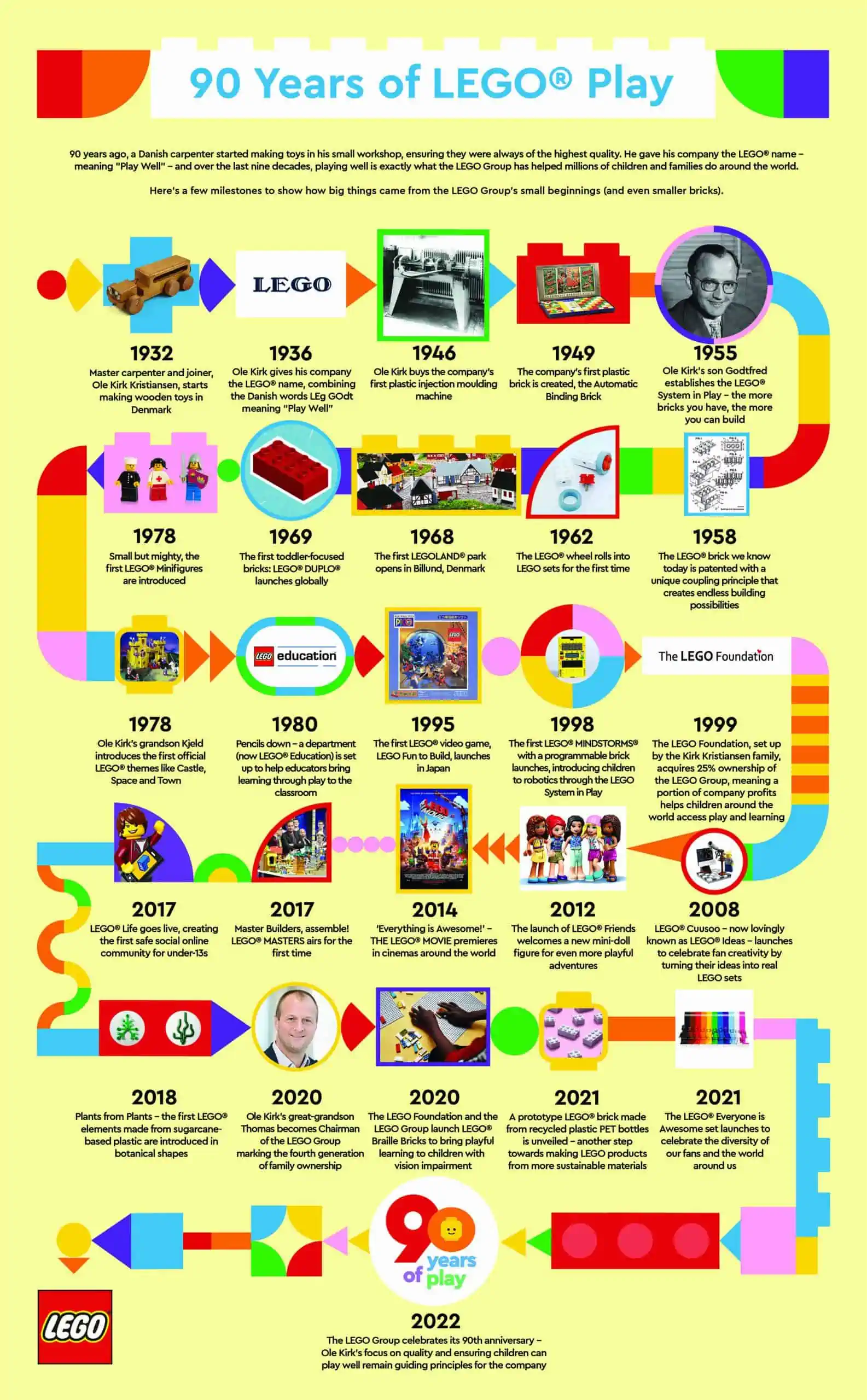My son recently showed me the assembled Lego set of “The Office” TV show. With 1164 pieces, the number of features and details in that set was extremely impressive and highly meaningful to anyone who was a fan of the show.
This attention to detail, and the complexity involved in creating such a set with so many unique pieces, got me thinking about the incredibly flawless precision required in the entire Lego manufacturing, packaging and distribution process.
Let’s review the complexity of the Lego Supply Chain process.
The History of Lego
Lego was founded 1932 by Ole Kirk Kristiansen in Denmark, starting with the creation and production of wooden toys. With the production of interlocking toy bricks starting in 1949, made of plastic, originally called the “Automatic Binding Brick”.
The next several decades saw the introduction of Lego sets, mini figures, LegoLand, more features and capabilities, and pop culture related sets tying into popular movies and TV shows. Amazingly any brick manufactured since 1955 can interlock with any other brick.
The Lego brand now routinely ranks as one of the top 10 toys of all time, and is often ranked number 1. Whether you want to assemble a pre-kitted set, or you want to make a design limited only by your imagination, Lego remains popular amongst children and adults alike.

The Lego Supply Chain by the Numbers
On the surface it may seem that the production, distribution of a line of standard plastic bricks would constitute a relatively simple Supply Chain. But this could not be further from the truth.
Consider that Lego sells over 75 billion bricks (and pieces) annually. That means they make over 200 million bricks each and every day of the year, which is almost 10 million pieces per hour.
Now consider that there are over 3700 unique pieces, which means there are over 3700 different plastic moulds. I expect that each of these 3700 moulds would be required at virtually every factory.
Now layer in the fact that there are over 60 different colours. While every piece does not likely come in every possible colour, the fact that 3700 different pieces can each come in a plethora of colours, that means that each colour of each piece must require a unique part (or SKU) number.
Lego currently has 5 different manufacturing sites in Denmark, Czech Republic, Hungary, China and Mexico. They are planning to add additional facilities in Vietnam (2024) and Virginia (2025) to their network. All facilities perform moulding, processing and packing operations.
The manufacturing operations consist of rows of plastic injection moulding machines, fed automatically with plastic granules from raw material storage silos. Robotic retrieval, storage, and picking of the moulded pieces then takes place.
Specialized machinery performs any necessary customization of pieces (eg. placement of faces on the heads or bodies of mini figures). Note that there are over 12000 different mini figures.
Finally, there have been over 19000 different sets of Lego pieces. Sets range from the simple kitting of standard bricks of various colours and sizes, to the complicated kitting of sets with thousands of unique pieces with extensive instruction booklets.
These sets are created automatically as unique pieces are fed along kitting lines with essentially automated pick and pack of pieces into these kits. Using optical sensor technology and extremely precise in-line electronic weigh scales, the accuracy required in this kits has to be virtually perfect. Apparently only 18 of every million pieces produced is defective.
Finally these kits are put in plastic packs and are placed in retail packaging unique to each set. Some kits have only one package of parts whereas bigger sets can have multiple bags of parts.
Once the sets are completed and packaging is finalized, they are ready to be shipped to innumerable distributors, retailers and also directly to consumers in accordance with customer orders and demand.
Where is the Complexity?
As we have described the Lego Supply Chain the complexity in scheduling, manufacturing, material handling, inventory control, logistics management and distribution is readily apparent. This complexity is made even more intense by the inflexible need for perfect execution.
The fact that Lego appears to execute their Supply Chain flawlessly is understood. Excellent execution merely reflects the outstanding leadership, planning, process management, and employee teams that make it all happen.
From a demand planning vantage point it needs to be further understood that over time different sets are retired and new sets are introduced to the market. Some sets will be more or less popular in different parts of the world.
Sets will see higher or lower demand at different times of the year. For instance the Christmas holiday season will be a huge driver for Lego demand. The popularity of a set timed to be released commensurate with the release of a new movie or other promotional event, across geographies, will also influence demand.
Certainly the Lego Supply Chain was not immune to the pandemic and its ongoing repercussions. Higher costs of petroleum and logistics have been passed along to consumers.
The future opening of new factories in the U.S. and Vietnam will serve to shorten Supply Chains in those geographies, reduce exposure to logistics issues, and de-risk any future delivery or continuity of supply issues.
Conclusion
The popularity of Lego has never been higher. It is one of the most recognizable and trusted brands in the world, thanks to the tremendous team at the company, from Marketing and Design through to Procurement, Manufacturing, Supply Chain and Distribution.
No matter what complexity Marketing and Design present to the Supply Chain team they step up, at least that is the way it looks on the surface. I am sure that there are the same day to day issues that plague any organization. But whatever they are is largely invisible to their customers and the general public.
Unlike the empty shelves that we see for other products, stores still seem to have lots of Lego product on hand. There may be lessons for others to learn from Lego in how they manage their supply-demand planning along with the great execution evident throughout the Lego Supply Chain.
That is a testimony to the strength and resilience of the Lego Supply Chain team. They have pieced together a Supply Chain that is highly enviable.

